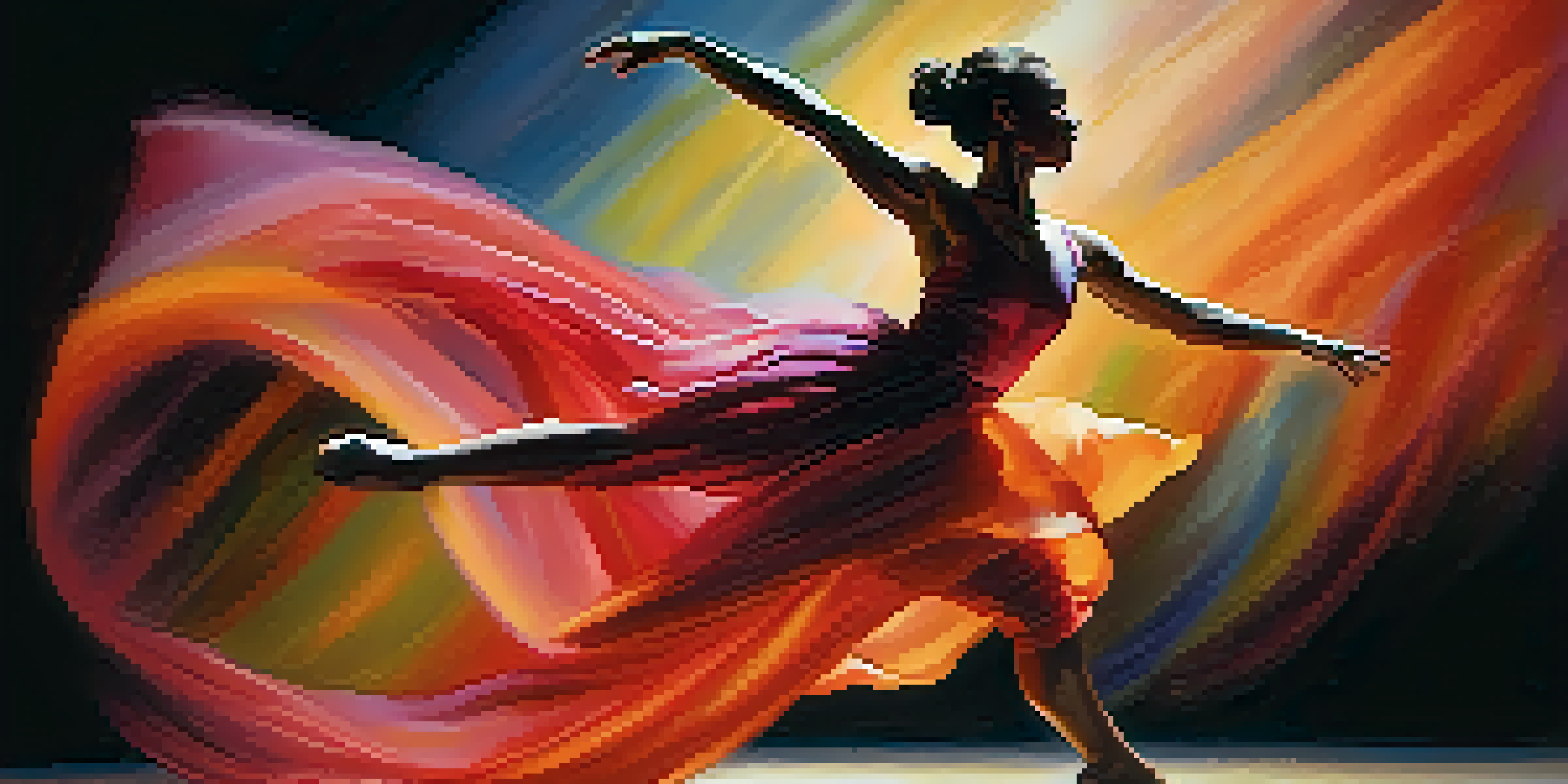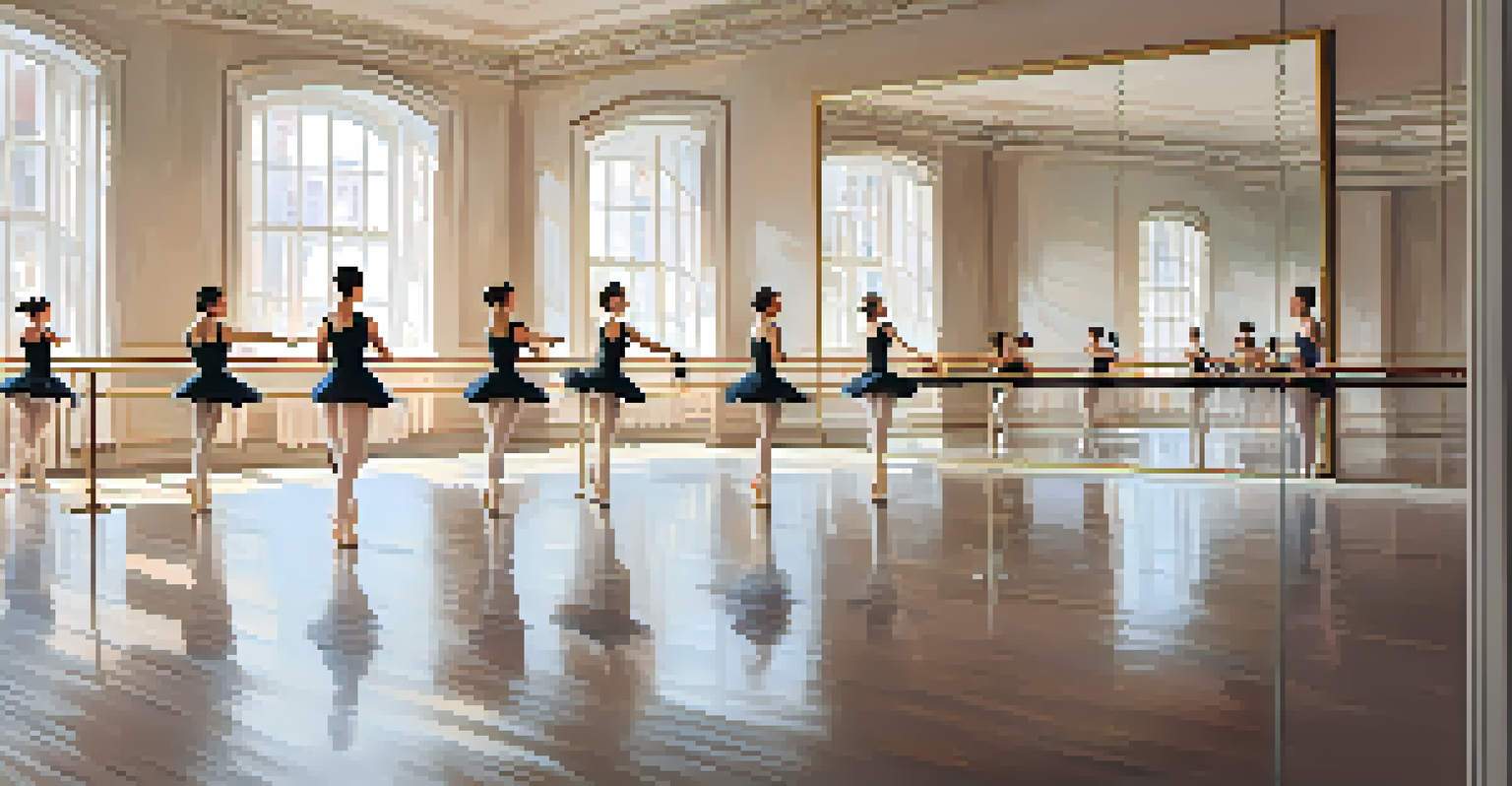Choreographic Storytelling: Crafting Narratives Through Movement

The Essence of Choreographic Storytelling Explained
Choreographic storytelling merges dance with narrative, creating a unique form of expression. At its core, it’s about conveying emotions and stories through movement, allowing audiences to connect on a deeper level. Think of a ballet performance that narrates a classic tale; every leap and turn adds layers to the storyline.
Dance is the hidden language of the soul.
This art form is not limited to traditional dance styles. Contemporary choreographers often experiment with various genres and techniques to craft their narratives. By blending styles, they can evoke a wide range of emotions, from joy to sorrow, illustrating the power of movement in storytelling.
Ultimately, choreographic storytelling is about creating a dialogue through movement, where the body becomes a vessel for narrative. As viewers, we are invited to interpret and feel the story being told, making each performance a personal experience.
The Historical Roots of Dance as a Narrative Form
Dance has been used for centuries as a means of storytelling, with historical roots in rituals and cultural celebrations. For example, Native American dances often depict stories of nature, heritage, and spirituality, showcasing the importance of movement in preserving cultural narratives. These early forms of dance set the stage for more structured storytelling in performance art.

As time progressed, ballet emerged in the courts of Europe, introducing formalized techniques that combined storytelling with elaborate choreography. The classic ballets like 'Swan Lake' and 'The Nutcracker' exemplify how movement can convey complex narratives, captivating audiences with both grace and emotion.
Dance as a Narrative Art Form
Choreographic storytelling combines movement and narrative, allowing audiences to connect emotionally through the expression of stories.
Today, the legacy of these historical practices continues, with modern choreographers drawing inspiration from traditional forms while innovating new ways to tell stories. This blend of past and present enriches the art of choreographic storytelling, allowing it to evolve and thrive.
Key Elements That Shape Choreographic Narratives
Several key elements contribute to effective choreographic storytelling, including movement vocabulary, music, and staging. Movement vocabulary refers to the specific gestures and techniques used to express emotions and themes. For instance, sharp, angular movements might convey tension, while fluid, flowing motions can indicate peace.
The body says what words cannot.
Music plays a crucial role in enhancing the narrative. A well-chosen score can elevate the emotional impact of the choreography, guiding the audience's feelings throughout the performance. Imagine a dramatic scene underscored by powerful orchestral music that matches the intensity of the dancers’ movements.
Staging and spatial design also significantly influence storytelling in choreography. The arrangement of dancers in space can create visual dynamics that reflect the narrative, drawing the audience's eye to key moments. Together, these elements weave a rich tapestry of movement and emotion, making the story resonate.
Emotional Connection: Engaging the Audience Through Movement
One of the most powerful aspects of choreographic storytelling is its ability to evoke emotions in the audience. When dancers express raw feelings through their movements, it creates a visceral connection that transcends words. This emotional engagement is what makes dance a universal language.
For example, a performance depicting heartbreak can resonate deeply with viewers who have experienced similar feelings. The dancers’ physical expressions of sorrow and loss can transport the audience into their world, making the story unforgettable. This connection is what keeps audiences coming back for more.
Key Elements of Dance Storytelling
Effective choreographic storytelling involves movement vocabulary, music, and staging, all working together to enhance the narrative.
Moreover, choreographers often encourage audiences to interpret the movement personally, allowing for a range of emotional responses. This subjective experience adds richness to the narrative, as each viewer brings their own stories and feelings into the performance, creating a shared journey.
Choreographic Techniques for Effective Storytelling
Choreographers employ various techniques to enhance storytelling in dance. One popular method is the use of motifs, or recurring movements that symbolize specific themes or characters. This repetition helps to reinforce the narrative, making it more cohesive and memorable.
Another technique is the juxtaposition of contrasting movements, which can highlight tensions within the story. For instance, a frantic solo might be followed by a serene group dance, showcasing the emotional rollercoaster characters experience. This contrast can effectively draw the audience into the turmoil of the narrative.
Additionally, the strategic use of pauses and stillness can be incredibly powerful. Moments of silence in between dynamic sequences allow the audience to absorb the emotions and reflect on the story, creating a deeper, more impactful experience.
Contemporary Examples of Choreographic Storytelling
Many contemporary choreographers are pushing the boundaries of storytelling through dance. For instance, the works of choreographers like Akram Khan and Crystal Pite often blend personal narratives with broader social themes, making their performances resonate on multiple levels. Their ability to weave complex stories using innovative choreography has redefined modern dance.
In the realm of musical theater, productions like 'Hamilton' showcase how choreography can elevate storytelling. The dynamic dance sequences not only enhance the musical elements but also serve to propel the narrative forward, engaging the audience on multiple fronts.
The Future of Dance Narratives
Innovations such as technology and social media are transforming choreographic storytelling, making it more accessible and dynamic for global audiences.
These examples illustrate that choreographic storytelling is a living art form, continually evolving and adapting. By embracing new ideas and techniques, contemporary choreographers are making the art of storytelling through movement more accessible and impactful than ever.
The Future of Choreographic Storytelling
As we look ahead, the future of choreographic storytelling is brimming with potential. With the rise of technology, we are beginning to see innovative collaborations between dancers and digital artists, creating immersive experiences that push the boundaries of traditional performances. Imagine a dance piece that integrates augmented reality to enhance the storytelling experience.
Moreover, social media platforms have opened new avenues for choreographers to share their narratives with a global audience. Short dance videos can tell powerful stories in just a few moments, allowing for wider reach and engagement. This democratization of dance storytelling encourages diverse voices and perspectives.

Ultimately, the evolution of choreographic storytelling will continue to reflect the complexities of our world. As artists explore new themes and mediums, we can expect to see even more captivating narratives unfold through the art of movement.